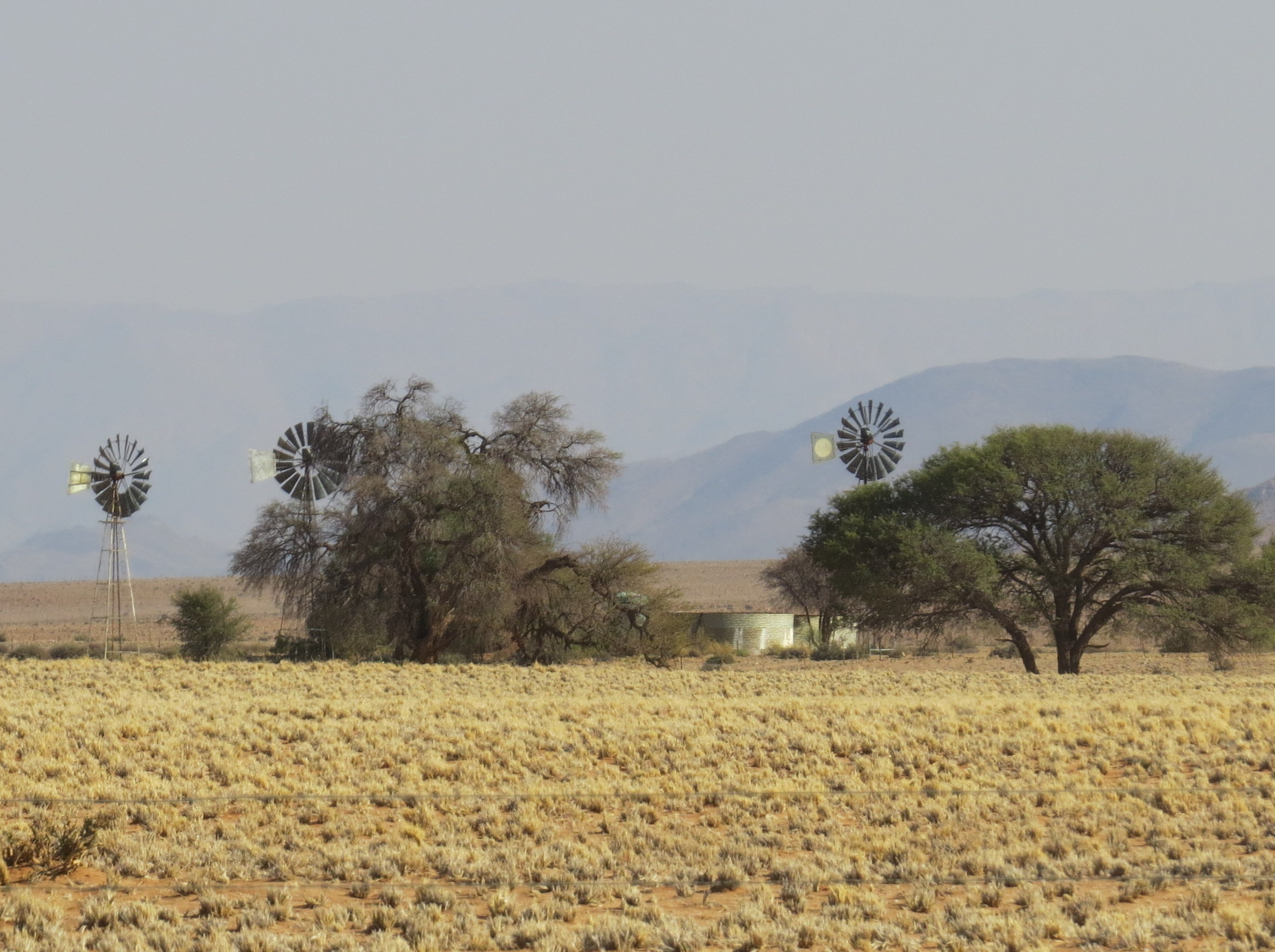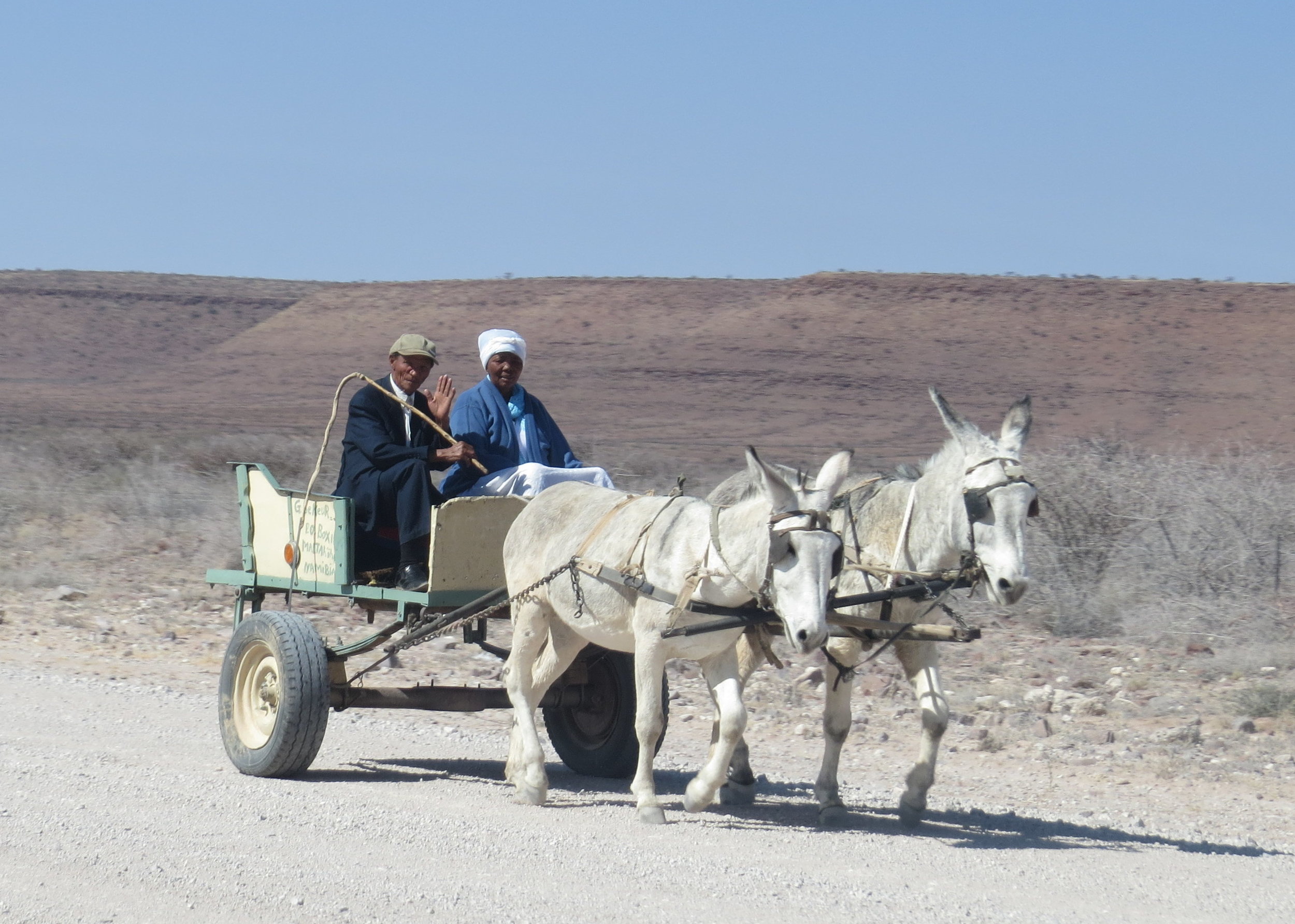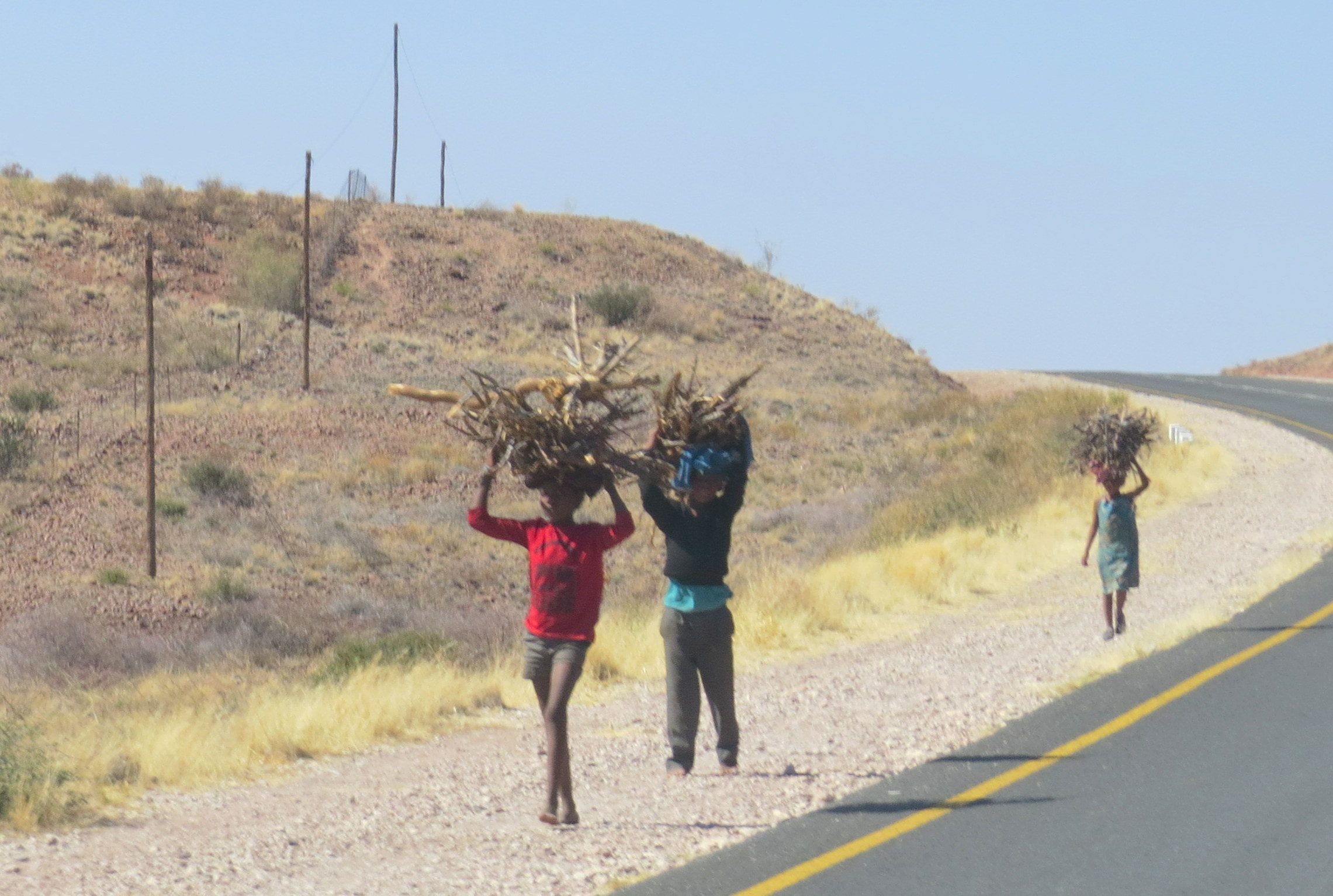Namibia ... Diamonds, deserts and daunting
Home to the Namib Desert, considered to be the oldest desert in the world, its name Namib derives from the Nama language and means "vast place". We visited by land first in 2007 and then by sea in 2015. Come with us to explore this ancient land, the hardy animals that survive here, ghost towns, the world's tallest sand dunes and endless deserts.
Republic of Namibia
Capital City: Windhoek
Land area: 382, 261 sq miles ... about 1/2 Alaska
Population: ~2.48 million (est 2016)
Language: English, but German, Afrikaans and native languages spoken
Currency: Namibian dollar (same as SA Rand)
Highest Point: Konigstein, ~8,550' (2,606m)
Government: Parliamentary republic headed by a President
Political Units: 13 Regions
Chief products: Copper, diamonds, uranium, lead, zinc
Previously known as German Southwest Africa, Namibia only became independent from South Africa in 1990. It is the first country ever to incorporate environmental protection into its Constitution.
In 2007, we originally planned to sail to Namibia from South Africa and then, as usual, we ran out of time, but didn't want to miss the opportunity to visit this interesting country of deserts, the Kalihari to the east and the Namib Desert along the Atlantic coast. So we rented a car and drove from Cape Town with the primary intent of seeing Etosha National Park, the finest game park in Namibia and one of the best in South Africa. It was an 1,800+ km drive but we weren't disappointed for our efforts. We had the opportunity to spend 4 days in the park and slept in park rest camps (very comfortable and very affordable) each night affording us the chance to view floodlit waterholes during the night. Though it was considered the off-season for animal viewing, it was prime season for the birds. We were delighted with what we did see and experience. We saw something new each day on the many gravel roads that crisscrossed throughout the park. We couldn't drive a kilometer down the road without seeing animals...sometimes in great numbers ... herds of springboks and zebras. It was fantastic!
Etosha National Park - Namibia's Gem
We saw lions every day, but this encounter on the second day was the most exciting. This male was lying on the side of the road under a tree about 10 feet away from us.
We were thrilled to see our first giraffes in the wild and there were lots of them. They crossed in front of us, behind us and munched on trees beside us. It was a thrill watching their long necks and heads peek out from between and above trees.
The bird life was most impressive. We purchased a park map which offered a good identification guide to animals and birds. We used it constantly. Here's just a sample of what we saw.
We would typically head out of the camp at sunrise when the gates opened since it seemed the best time for game viewing. Once it got hot in the afternoon, the animals hunted for shade and we headed back to the camp for rest.
An etosha traffic jam ! We saw thousands of springboks (above), as well as kudu, eland and impala.
We had breakfast with zebras one morning as they gathered in great numbers at a waterhole. We sipped our tea, ate our yogurt and just watched them for an hour as they socialized with each other. What an unforgettable experience. We find ourselves humming "Whim a way" quite often. It was all about the animals and we loved every minute.
Along the Skeleton Coast
We regretfully left Etosha and headed west towards the inhospitable Skeleton Coast, infamous graveyard of ships. It was named "skeleton", we're told, because if you managed to survive the wreck and made it to land, you would probably die of exposure in the desert or be eaten by the local animal population. There are few stops along the coast and the gravel road seemed to stretch forever. Even today, wrecks are not uncommon as evidenced by the ship in the photo which had gone aground just months before and was left to break up.
Down the coast to Swakopmund, simply "Swakop" to the locals. A mix of German and bohemian, the city, though lovely, smacked heavily of tourism and Euro influence. We wandered a bit, stayed the night and moved on.
Swakop view
A spectacular African sunset viewed from our hotel room in Swakop
Walvis Bay was more to our liking. Though still a bit touristy, it was smaller and more laid-back than Swakop. We stayed a couple of days and enjoyed walks along the beach and a hotel with A/C and wi-fi ... absolute luxury! Walvis is also a large salt harvesting facility. Some areas appeared to be ice packed with snow and others gleamed like the mirror surface of a skating pond. Watching bulldozers plow the salt into large rows for harvesting and later into 30-meter high mountains was fascinating.
Namib Desert
Stretching 1200 miles and averaging only about 70 miles wide, the Namib Desert is home to the tallest sand dunes in the world ... obviously a must-see. In the Nama language, Namib means "vast" and this proverbial dune sea lived up to expectation. The Namib-Naukluft National Park (50,000 sq km) is the largest conservation area in Namibia and one of the largest in the world.
Sesriem - Namib-Naukluft National Park
Dune 45 was so named because it is located 45 km from the entrance is an easier climb than most. But trying to climb a mountain of soft sand, the wind howling, taking one step, sinking in, sliding back two, proved to be a challenge. I lagged behind David to take photos and had grit and sand in my camera (and other places) for days after.
Hardap Dam Reserve
We knew it was time to head back to South Africa, but we stopped for a day at the Hardap Dam Reserve not too far out of the way. This dam, the largest in Namibia, retains the largest lake in the country and is surrounded by a game park.
The unusual quiver tree above is so-named because the indigenous people used the branches as quivers for their arrows.
Finally, we couldn't put off the inevitable. It was time to return to South Africa. "Cups" was waiting for us and so was Jelly (some cruiser friends were cat-sitting). As usual, we could have toured about for months instead of a mere three weeks and as we recounted all we had seen, we also noted what we had missed. Sounds like an opportunity for a return visit.
Fast forward to July 2015 ...
And return we did ... this time with Nine of Cups! Much to our pleasant surprise, we reached Lüderitz (LEW-der-its) in 77 hours. It was 486nm ... Royal Cape YC Berth 25 to the mooring in Robert Harbour, Lüderitz, with an average speed of 6.3 knots. You really have to love a town with an umlaut in its name (ü – those two little dots above the u). The forecast for several days of southerly winds was unusual for this time of year along the southwest African coast, but was most welcome. Hooray! The ride had its ups and downs, but all in all, it was a very reasonable, albeit cold, passage. And here we were ... back in Namibia.
Entering Lüderitz port in July 2015
After checking in and resting a bit, we began our exploration of the town. Portuguese explorer, Bartholomeu Dias, was the first European ashore here in 1488 and named the town Angra Pequena (little bay). Adolph Lüderitz, a German merchant, arrived in 1884 with the intent of starting a trading post, as well as a foothold for the German Empire in Africa. The town's isolation at the edge of the Namib Desert along with the lack of fresh water and building materials hindered its growth. Ongoing clashes with local native people (the Nama and Herrero) added to the problems until a railway worker, Zacharias Lewala happened to discover a diamond in 1908 and turned it in to his supervisor. A diamond rush ensued causing the town to grow quickly. The rush lasted nearly 50 years. Today, diamonds are still a big part of Lüderitz's heritage and economy, but much less so than in the past. Fishing and tourism contribute to the town's economy and support its population of ~12,500 people, many of German heritage.
It's easy to see the German/European influence as we walked down Bismarck Street.
There was plenty to do around town when a break from boat chores was in order. We walked to Shark Island one day, a former German concentration camp for "indigenous rebels" ... the Cornelius Fredericks Memorial was particularly stirring. We met lots of the locals ... Liz from the Safari Shop who became and remains a good friend. Doris & Ian who shuttled us around to all the local hot spots and let us borrow their vehicle for a road trip.
Lüderitz's iconic Felsenkirche aka Church on the Rock, stands high on a natural granite pedestal known as Diamond Hill and is the tallest building in town.
Diamonds, Ghost Towns and Sperrgebiet
As we motored into Lüderitz harbor a few weeks ago, we noticed fishing boats with long tubes/hoses extending into the water off their sterns. We'd never seen anything like this before and we wondered what they were. The answer? They're used for sucking up diamonds from the seabed.
In June 2002, the largest diamond, a 17.4 carat gem quality diamond, was recovered from the Lüderitz offshore concession by the mining vessel mv Namakwa. It was the largest diamond ever recovered by marine mining in the area.
Kolmanskop - A Diamond-Mining Ghost Town
We've certainly been to ghost towns in the old Wild West … usually abandoned when the gold and/or silver ran out. Here, it's diamond ghost towns. We headed 10km (6 miles) out of town into the desert to once vibrant, now abandoned Kolmanskop (aka Kolmanskuppe). In 1907, railroad worker Zacharius Lewala found a shiny stone and gave it to his boss, August Stauch, who subsequently found many more “shiny stones”, quit his job and filed a mining claim in the area. As soon as word got out, a diamond rush ensued and, by 1908, diamond fever was rampant. By 1912, Kolmanskop had become one of the richest towns on the planet with all the luxuries imaginable. It had its own Millionaire's Row, a large outdoor swimming pool, a bowling alley, a gym and entertainment hall, the first tram in Africa and even an ice making factory! A state-of-the-art 200-bed hospital had been built which boasted the first X-ray machine in the southern hemisphere. The x-ray machine was not however, expressly for broken bones, it was used frequently to detect diamonds “hidden” on workers' bodies. Now ... the once rich town is a tourist attraction ... ramshackle, old buildings being gobbled up by the desert. Read more about Kolmanskop here.
What the heck is Sperrgebiet?
Sperrgebiet (pronounced spur-geh-beet) translates from the German to “Forbidden Area”. It's also known as Diamond Area 1 and it's the exclusive diamond mining area of southwestern Namibia. It extends along the Namibian coast from the South African border at Oranjemund for about 200 miles (320km) north ... about 45 miles north of Luderitz. Big fines for entering and possible imprisonment. Read on ...
Wild Horses and a 1934 Hudson
Rent a car and drive 75 (125km) miles out of Lüderitz into the Namib Desert? Wild horses couldn't drag us there! Well, actually, they could. We did hire a car and drove 75 miles to view the wild desert horses at Garub.
Not far up the road from the wild horses lies the tiny town of Aus. The word “Aus” in German translates to “out”. But then, the Khoi-Khoi word translates to “place of the snakes”. Hmm … perhaps this really wasn't a place we wanted to visit? Aus was an internment, “prisoner of war”, camp after the Germans surrendered to the South African troops in WWI. We traveled along a bumpy, gravel road to view the war memorial and the ruins of the site then headed to the little town itself which we found wasn't much at all. The tourist info office, which we'd heard good things about, was closed. Aus is the end of the line for the train which primarily is used for ore movement.
Bullet-riddled, rusting hulk of a 1934 Hudson in the middle of nowhere
Just out of town, we found a gravel road that looked inviting. We followed its circuitous path and there up ahead in the distance, we saw a car … a very old, rusting hulk of a car … a 1934 Hudson Terraplane, to be exact. It seems there's an interesting story associated with this old car that goes something like this. The two thieves who owned the car stole diamonds from the Sperrgebiet (Forbidden Diamond Area) and were chased into this canyon by the Diamond Detectives, who shot them dead. There are bullet holes in the car door to prove it. The diamonds, however, were never recovered. It is said that on moonlit nights, the thieves haunt the Geisterschlucht (Ghost Canyon) still hunting for their diamonds. We saw no sign of ghosts nor diamonds, but this car in the middle of nowhere was cool.
Windhoek, Namibia's Capital City
Our new friends, Doris & Ian, had a slight problem. Doris was flying from Windhoek back to Germany and Ian was not able to get the time off to take her to the airport ... 9 hours away. Would we drive her there and then we were welcome to keep the car and tour around for a week or so? Ah ... let us think about this for a nanosecond ... Absolutely! Much of the road to Windhoek is gravel ... bumpy and dusty.
We reached Windhoek in late afternoon. Windhoek, German for “wind corner”, is located in the center of the country. It's Namibia's largest city, but a fairly small city with a population of ~325,000 people. Doris was a great guide and we took advantage of her last day exploring the city.
The largest known meteor shower to hit Earth was discovered near Gibeon, Namibia and documented in 1838 by explorer, J. E. Alexander ... although the locals were known to have been hammering pieces of it into implements for generations. Several chunks of the meteor are mounted on pedestals in the middle of the plaza. Based on a few empty pedestals, we assume some of them developed feet.
With Doris safely on her flight back to Germany, we headed out of town and the roads soon turned to gravel once again. We were heading once again to the Namib Naukluft National Park to the west. Getting from here to there in Namibia takes a long time. After descending the steep Spreetshoogte Pass, we continued on and on and on via hard, bumpy, gravel roads, rarely meeting another car. When we did, swirls of dust blinded us momentarily.
Oryx (gemsbok) seemed to be the most common residents in this part of the world. Sometimes they grazed peacefully, raising their heads as we passed. Other times, they crossed in front of us or raced alongside us. We never tired of seeing them.
We spent a night in Solitaire ... not much there, but a welcome respite from driving in the desert en route to Namib Naukluft National park.
We'd visited this national park on our last visit to Namibia, but you never get to see everything in one trip, so another visit to the world's highest sand dunes in the world's oldest desert was on the itinerary. We weren't disappointed.
We had hoped to stay at Sossusvlei, but there was no room at the inn. Instead, we discovered the Hammerstein Lodge and were thrilled with the prospect of a "cat walk" ... meeting some wild felines ... up close and personal.
How many people can say they've patted a cheetah or a leopard? I can ... and, man, what a thrill! Take a look at this video!
We weren't sure we could top petting wild cats, but after the cat walk, we found a castle in the middle of the desert which has certainly raised the bar for unusual trip experiences. When we read about Duwisib Castle, we thought it was probably just a big house that the locals referred to as a castle. Au contraire … this is a fine, 22-room castle in the middle of nowhere, now owned and operated by NWR (Namibia Wildlife Resort) and we stopped for a visit. One of the best parts of touring the castle? Meeting up with Samantha Fadein who gave us a lesson in her native click language, Damara-Nama. Take a look!
Duwisib Castle ... a 22-room castle in the middle of nowhere.
It was time to start thinking of returning to Lüderitz. Several folks had recommended driving D707, referred to as the Dream Road, the Garden Route and the most scenic road in all of Namibia. The road was long, dusty and bumpy and definitely not "dreamlike". Perhaps we were tiring of gravel roads and desert nothingness and thoughts of Nine of Cups returning to the sea were foremost in our minds. With 2000 km (1240 mi) under our belts, we were content to head back to port and prepare for our upcoming Atlantic crossing.
And then we were hugging friends goodbye and sailing the south atlantic bound for st. helena island. Join us there!




















































































